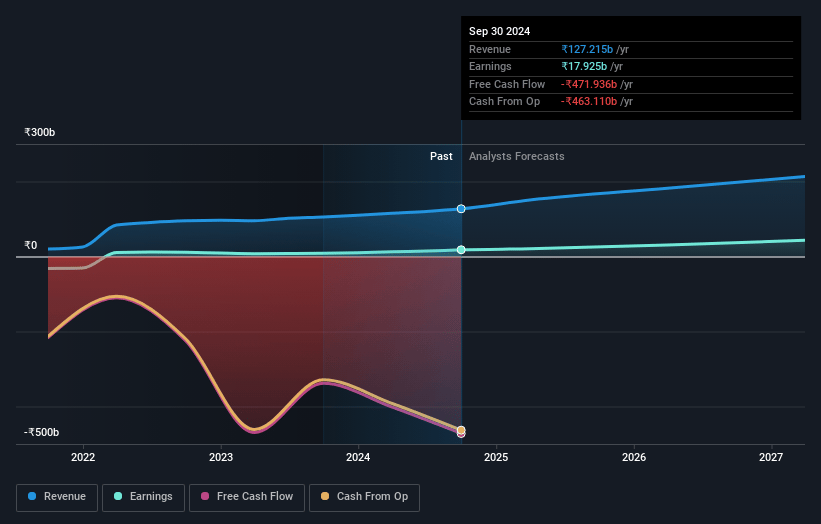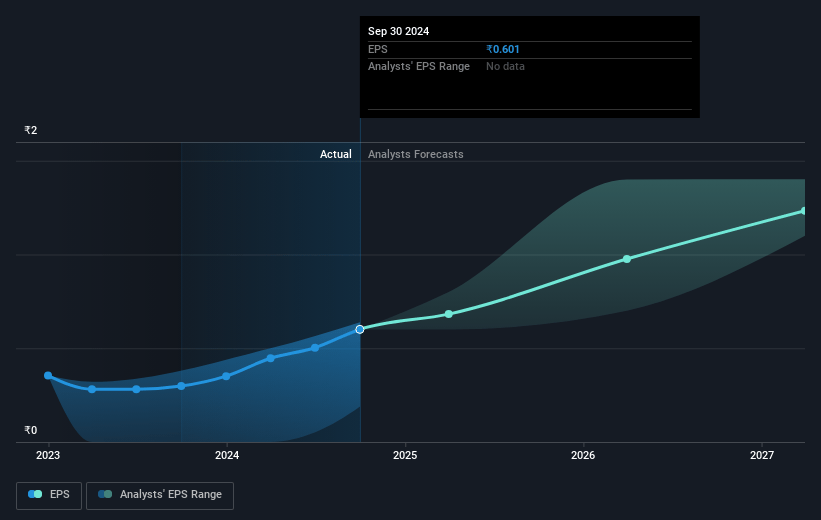Narratives are currently in beta
Key Takeaways
- Investments in low-yield assets and a shift toward corporate loans could pressure net interest margins without accelerated retail growth.
- Elevated slippages in unsecured segments stress asset quality, requiring higher provisions and affecting earnings stability.
- Strong deposit growth, improved asset quality, robust earnings performance, credit rating upgrades, and strategic SME focus enhance Yes Bank's financial stability and profitability.
Catalysts
About Yes Bank- Engages in the provision of banking and financial products and services primarily in India.
- The bank's continued investment in RIDF (Rural Infrastructure Development Fund) is expected to reduce net interest margins, as a significant portion (11% of total assets) currently yields low returns. This drag on profitability is highlighted by the projected persistence of this portfolio until at least March 2027. (Margins)
- Elevated levels of slippage, particularly in unsecured retail segments such as personal loans and credit cards, indicate ongoing stress. This is expected to impact asset quality, leading to higher provisions and affecting net earnings. (Earnings)
- While the bank has made strides in reducing its gross NPA ratio and improving its provision coverage ratio, the increase in credit slippages suggests that asset quality issues may persist, potentially impacting profit margins and cost efficiency. (Margins)
- The bank's emphasis on shifting its loan portfolio more toward corporate advances, which are usually lower yielding than retail loans, could pressure Yes Bank's net interest margins if retail growth does not accelerate as planned. (Margins)
- The historical performance of Yes Bank's equity and the larger equity base create challenges for providing dividends without significantly eating into profits, which could affect investor sentiment and the bank's cost of capital. (Earnings)
Yes Bank Future Earnings and Revenue Growth
Assumptions
How have these above catalysts been quantified?- Analysts are assuming Yes Bank's revenue will grow by 23.2% annually over the next 3 years.
- Analysts assume that profit margins will increase from 14.1% today to 21.0% in 3 years time.
- Analysts expect earnings to reach ₹49.9 billion (and earnings per share of ₹1.23) by about January 2028, up from ₹17.9 billion today. However, there is a considerable amount of disagreement amongst the analysts with the most bullish expecting ₹55.0 billion in earnings, and the most bearish expecting ₹30.8 billion.
- In order for the above numbers to justify the analysts price target, the company would need to trade at a PE ratio of 19.5x on those 2028 earnings, down from 34.3x today. This future PE is greater than the current PE for the IN Banks industry at 12.4x.
- Analysts expect the number of shares outstanding to grow by 8.89% per year for the next 3 years.
- To value all of this in today's terms, we will use a discount rate of 13.57%, as per the Simply Wall St company report.
Yes Bank Future Earnings Per Share Growth
Risks
What could happen that would invalidate this narrative?- The bank has consistently outperformed the industry in deposit growth, particularly in current and savings accounts, which can lead to increased revenue and potentially stabilize or increase the stock price due to strong financial fundamentals.
- Improved asset quality parameters and a reduction in gross NPA ratio to 1.6% indicate better risk management, which can positively impact net margins and profitability.
- Significant growth in net profit driven by a 22% increase in operating profit year-over-year suggests strong earnings performance and resilience against market challenges.
- Credit rating upgrades by CRISIL and CARE for the bank's bonds reflect increased market confidence in the bank's financial stability and creditworthiness, potentially influencing positive earnings growth.
- Strategic focus on expanding SME and mid-corporate advances, along with optimized risk interventions in retail segments, positions the bank for improved revenue generation and profit margins.
Valuation
How have all the factors above been brought together to estimate a fair value?- The analysts have a consensus price target of ₹16.45 for Yes Bank based on their expectations of its future earnings growth, profit margins and other risk factors. However, there is a degree of disagreement amongst analysts, with the most bullish reporting a price target of ₹18.0, and the most bearish reporting a price target of just ₹14.0.
- In order for you to agree with the analyst's consensus, you'd need to believe that by 2028, revenues will be ₹238.1 billion, earnings will come to ₹49.9 billion, and it would be trading on a PE ratio of 19.5x, assuming you use a discount rate of 13.6%.
- Given the current share price of ₹19.63, the analyst's price target of ₹16.45 is 19.3% lower. Despite analysts expecting the underlying buisness to improve, they seem to believe the market's expectations are too high.
- We always encourage you to reach your own conclusions though. So sense check these analyst numbers against your own assumptions and expectations based on your understanding of the business and what you believe is probable.
How well do narratives help inform your perspective?
Disclaimer
Warren A.I. is a tool utilizing a Large Language Model (LLM) that ingests data on consensus price targets, forecasted revenue and earnings figures, as well as the transcripts of earnings calls to produce qualitative analysis. The narratives produced by Warren A.I. are general in nature and are based solely on analyst data and publicly-available material published by the respective companies. These scenarios are not indicative of the company's future performance and are exploratory in nature. Simply Wall St has no position in the company(s) mentioned. The price targets and estimates used are consensus data, and do not constitute a recommendation to buy or sell any stock, and they do not take account of your objectives, or your financial situation. Note that Warren A.I.'s analysis may not factor in the latest price-sensitive company announcements or qualitative material.
Read more narratives
There are no other narratives for this company.
View all narratives



